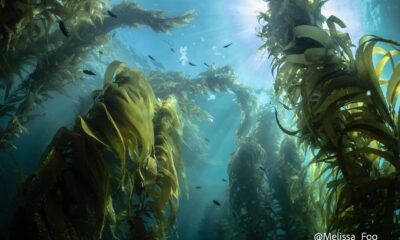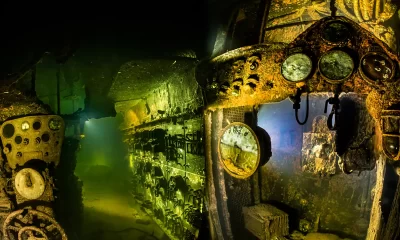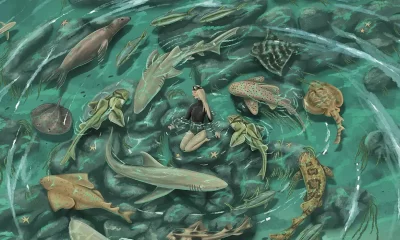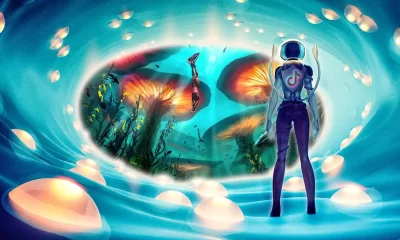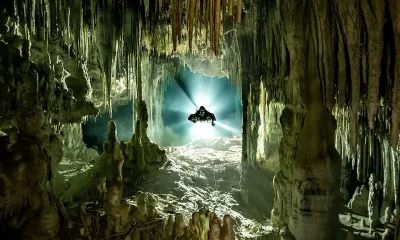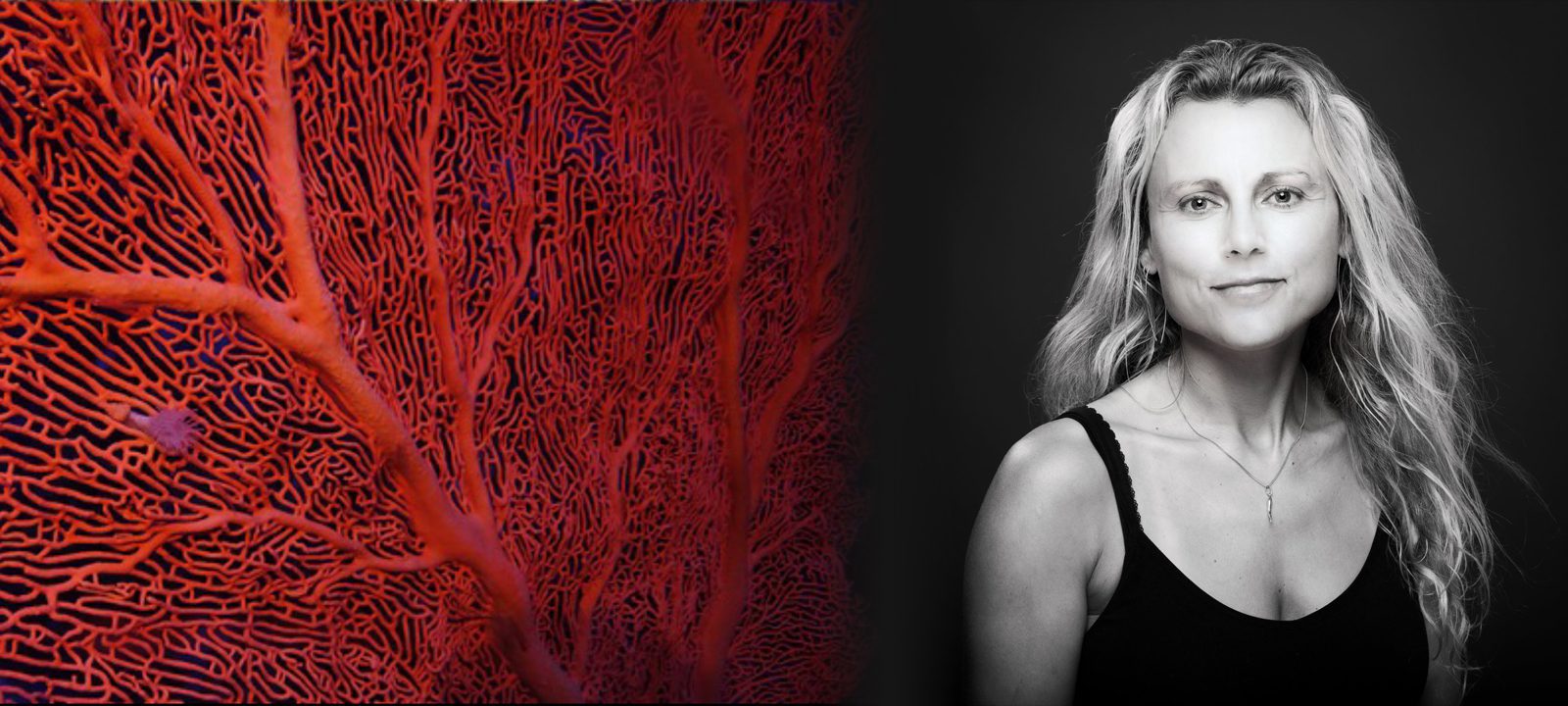
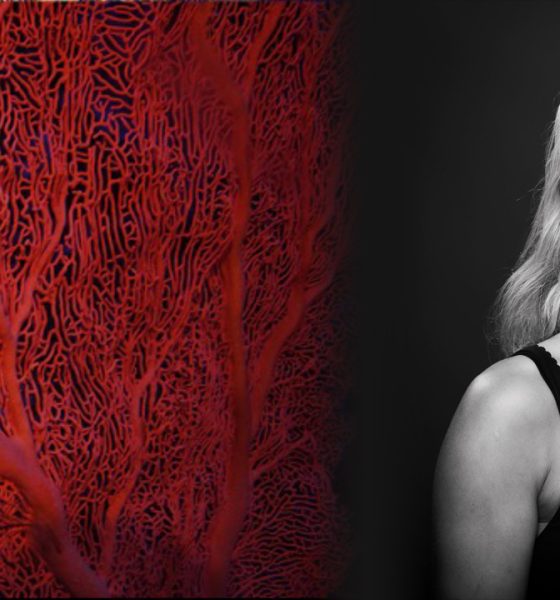
Art
GORG GROK
Marine biologist Dr. Sonia Rowley, aka the “Gorg Whisperer” takes us for a deep dive into the life of her octocorallia de désir.
Text and images by Dr. Sonia Rowley. Header Image: The enigmatic gorgonian Annella Gray, 1858 (left) taken at Pohnpei, Federated States of Micronesia at 60 m/197 ft depth with Dr. Sonia J. Rowley (pictured right).
At the beginning of 2014, I submitted my Ph.D. thesis on the Gorgonian (sea fan) corals of SE Sulawesi, Indonesia with the following statement: “First and foremost I am indebted to the sea fans themselves, who, through their sheer eloquence connect us to the oceans and wonders of nature; they, are my greatest teachers.”
Gorgonian corals are some of the most conspicuous and highly diverse creatures in the marine realm. Evocative images of exotic dive locations typically sport colorful fans amidst an array of reef fish. Yet, despite their splendor, this group of corals is remarkably overlooked. Why would this be?
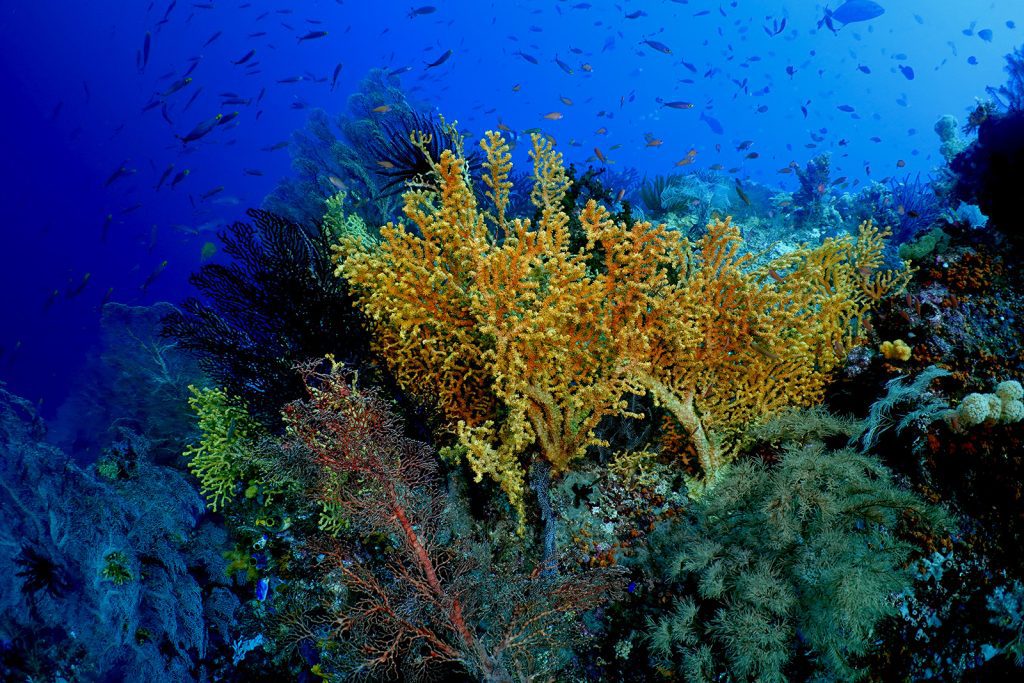
Depth: 46 m/151 ft
Max depth: 53 m/174 ft
Rebreather: Divesoft Liberty
Dive time: 63 mins
Diluent: Air
G/F: 30/80
Buddy: Julie Hartup, Micronesian Conservation Coalition
Image link: www.instagram.com/p/CC7QK66BWic
Gorgonians, like fish, simply don’t exist, they are not actually a thing! What?!? What does that mean? Gorgonians are within a Class of corals called Octocorallia, ‘octo’ meaning eight; 8 tentacles, 8 divisions within the polyp, all eight! Octocorallia is a monophyletic group, meaning that all the members of this group are related to a common ancestor. However, within Octocorallia, the division is complex and unresolved. Gorgonians are not all closely related to each other. They are polyphyletic; the species that are grouped together do not all come from a common ancestor, yet they all share very similar characteristics (e.g., axis type). In fact, gorgonians are all mixed in with soft corals and sea pens. So, what do we do with a quandary like that?
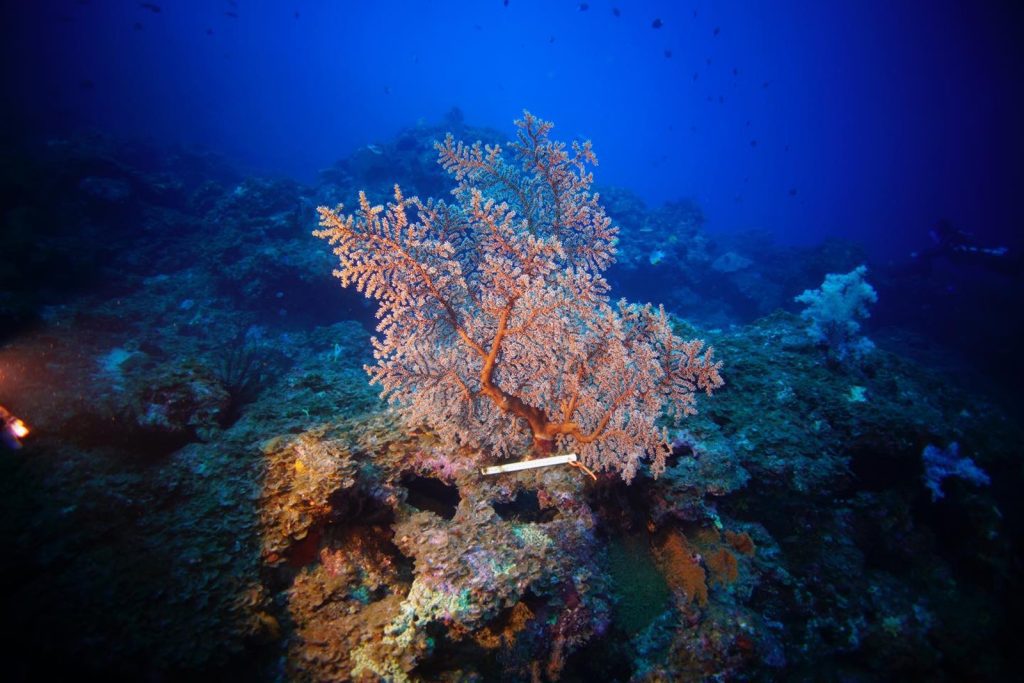
Depth: 36 m/118 ft
Rebreather: Divesoft Liberty
Dive time: 177 mins
Max depth: 51 m/167 ft
Diluent: 18/36
G/F: 45/80
Buddy: Sam Mason, Trawangan Diving, Matt Deberry, Dauntless Divers.
Image link: www.instagram.com/p/ChPGWwDu7Ug
This is a species within the soft coral genus Siphonogorgia Kölliker, 1874. It makes an excellent gorgonian, don’t you think? So did its early taxonomists. However, it’s not one. Good ideas emerge many times across nature—just look at wings! The term for this apparent similarity or relatedness in form is convergent evolution, whereby distantly related organisms have independently evolved the same characteristics in response to their environment.
Safety in Numbers
A fascinating part of gorgonian research is teasing apart who’s related to who, and why; how did various adaptations arise, and can the mechanics of their existence be superimposed on their phylogeny—their relatedness, if you will? The use of molecular techniques to corroborate what we see in the field continues to increase our understanding of these enigmatic corals, and strengthens our conviction on how much biodiversity is on a reef. This, in turn, enables regulators to take appropriate conservation measures. Yet, biodiversity assessments and subsequent conservation strategies are essentially human constructs against our own human influence.
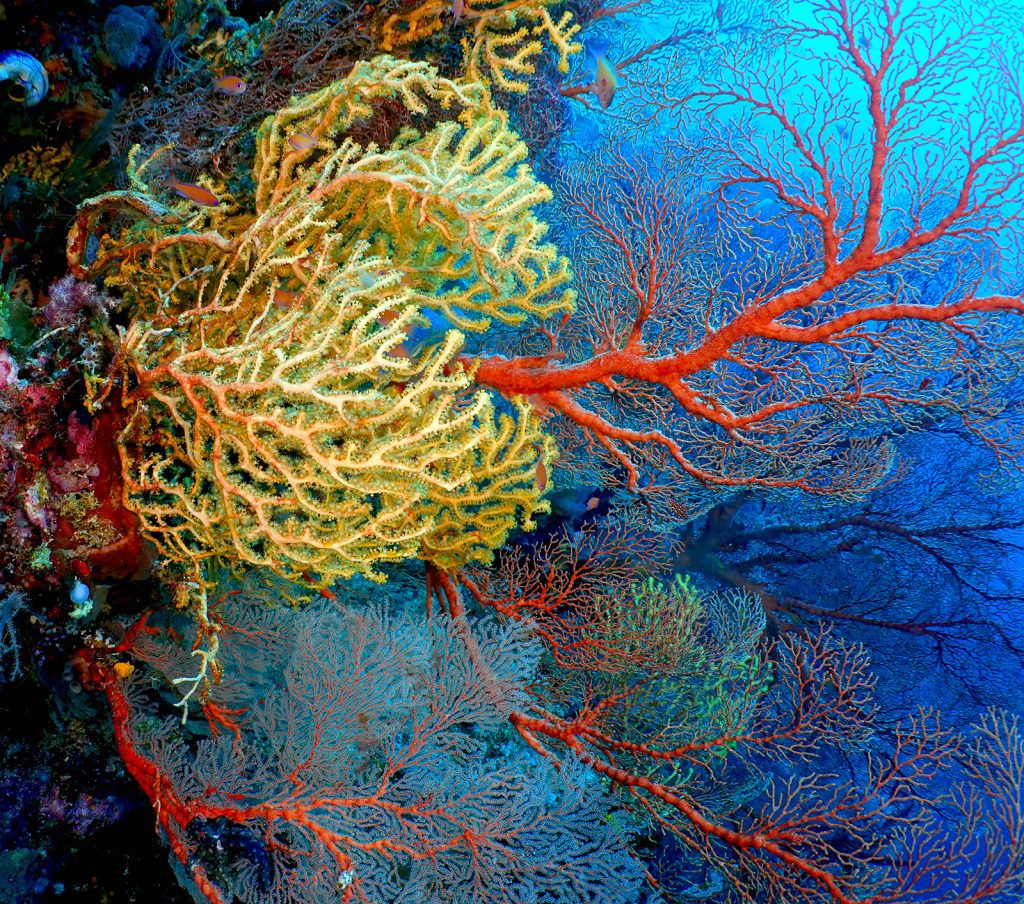
Depth: 53 m/174 ft
Max Depth: 53 m/174 ft
Rebreather: Divesoft Liberty
Dive time: 62 mins
Diluent: Air
G/F: 30/80
Buddy: Julie Hartup, Micronesian Conservation Coalition
Image link: www.instagram.com/p/B_J8uaQhX-x
Nonetheless, the biodiversity in the image below is in safe hands and taken very seriously by nearby communities. Ant Atoll is a UNESCO Biosphere Reserve with local rangers monitoring the atoll day and night. Here, nature’s adaptations can persist as intended, largely uninhibited by our influence. White gorgonians (Melithaea Milne Edwards, 1857) persist in the same habitat as these yellow-coloured black corals (Antipathes Pallas, 1766). Black corals and gorgonians often look very similar, with both coral groups featuring whip, fan, and bush species. With a keen eye, it is possible to determine the difference between the two coral groups and mesophotic depths are the perfect environment to flex those field ID muscles; the closer you look, the more delights you will see.
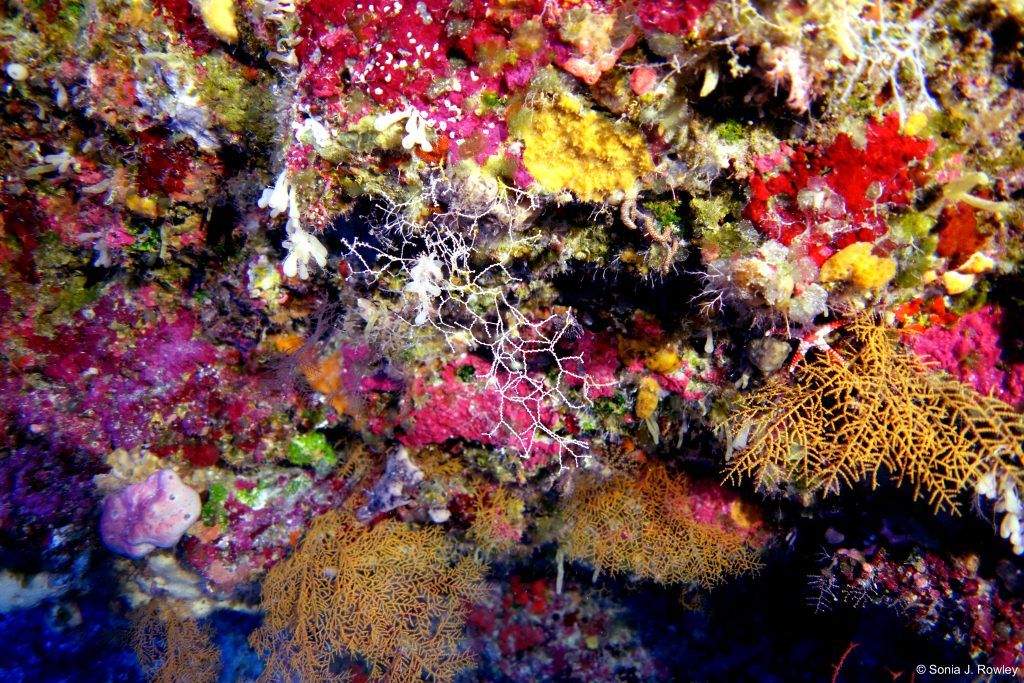
Depth: 75 m/248 ft
Rebreather: Poseidon SE7EN
Dive time: 276 mins
Max depth: 122 m/400 ft
Diluent: 7/70
G/F: 45/75
Buddy: Richard Pyle & Brian Greene, Bishop Museum
Image link: www.instagram.com/p/CUMltn-LJoN
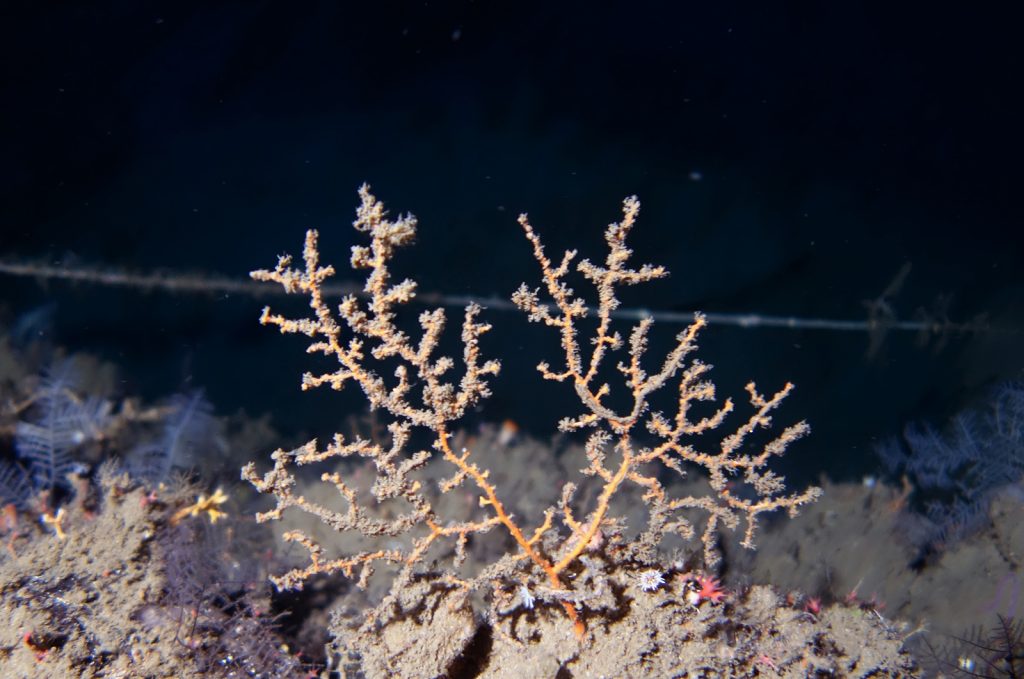
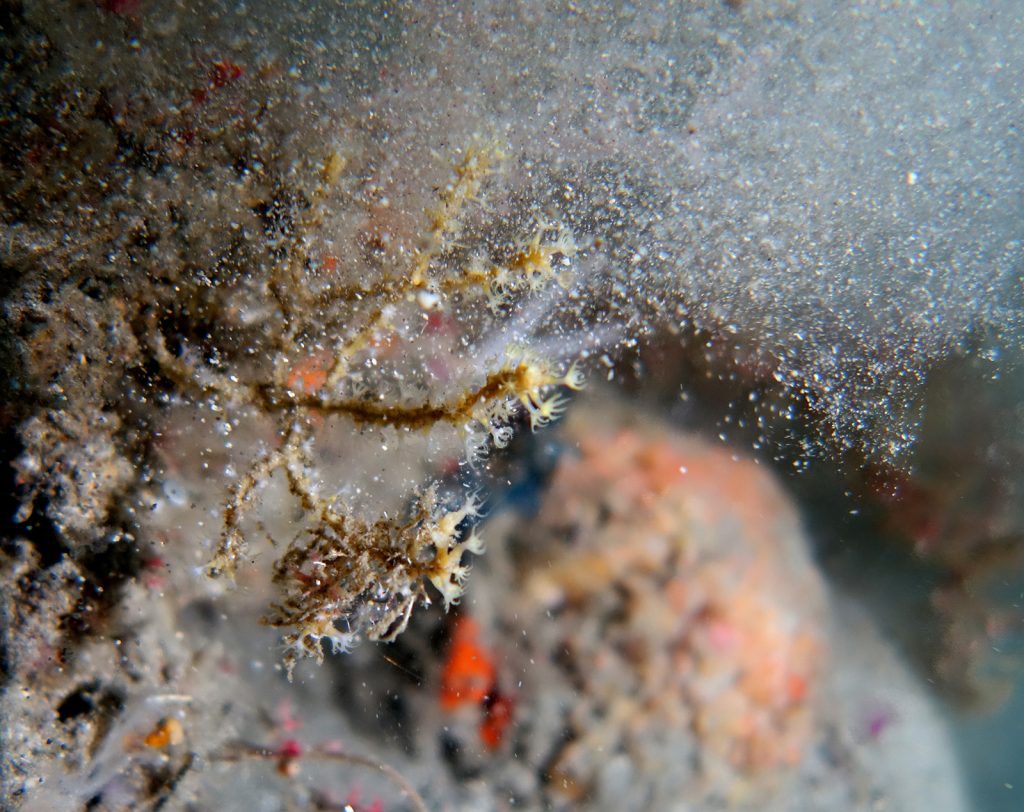
Depth: 92-141 m/302-463 ft
Rebreather: Poseidon SE7EN
Dive time: 244 mins
Max depth: 141 m/463 ft.)
Diluent: 7/70
G/F: 45/75
Buddy: Richard Pyle & Brian Greene, Bishop Museum
But, whilst gorgonians don’t exist as entity [or taxonomic/coral group], they do survive, adapt, and persist. Current estimates suggest that less than 4% of global marine ecosystems on the planet are actively protected (i.e., they are not paper parks). The deeper depths are neither isolated nor immune to the vicissitudes of human existence—fishing line, sedimentation, and pollution penetrate them, too. However, time and again gorgonians make it through. Even during my Ph.D. research in Indonesia, I discovered that a shallow water gorgonian turned to coprophagy to survive on reefs degraded by human effluent to the point that the genetic structure of the coral was even changing!
Chemically Well-defended
Many gorgonians have evolved a natural resilience or tactics that facilitate survival in challenging conditions. Not being able to get up and move, sessile (immobile) taxa such as gorgonians get inventive. Many species have a battery of chemicals to ward off unwanted invaders. But, gorgonians develop natural resilience by keeping the right company. Numerous species of Acanthogorgia Gray, 1858 can be very colorful, yet remarkably fragile. Thus, they tend to settle either at the base of larger chemically well-defended gorgonians or other aggressive stinging taxa on the reef, such as hydroids (image below) that pack a serious punch if you get anywhere near them. The gorgonian maintains its glory by sticking close to these knights in chemical armor.
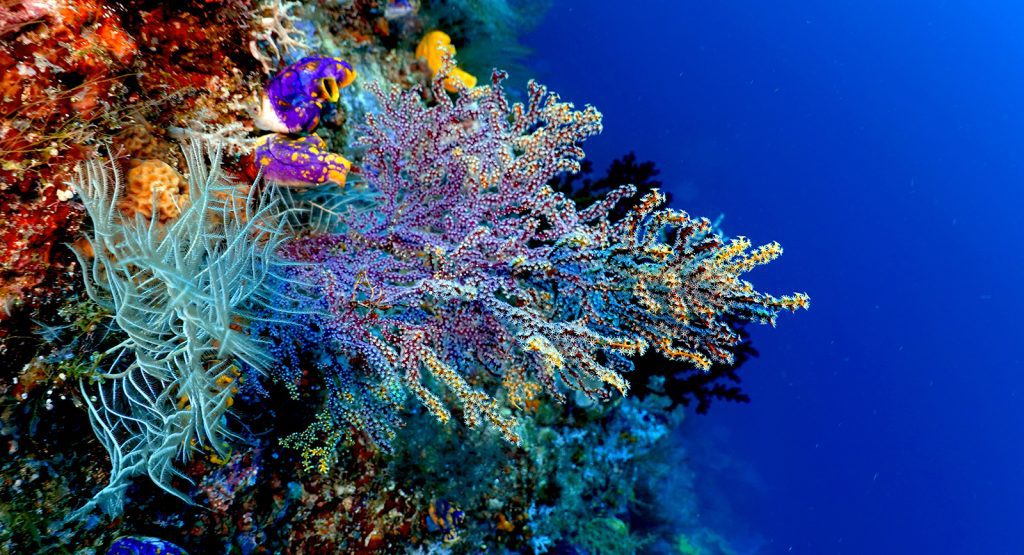
Depth: 53 m/174 ft
Max depth: 53 m/174 ft
Rebreather: Divesoft Liberty
Dive time: 62 mins
Diluent: Air
G/F: 30/80
Buddy: Julie Hartup, Micronesian Conservation Coalition
Image link: www.instagram.com/p/B_YwSUbBHLG
Lone Rangers
Where some corals like to hang together, others prefer to go it alone. The logarithmic beauty of the spiral has evolved several times in gorgonians. Many species of Viminella sp. (pictured below) can be found popping up in seemingly any reef environment and in waters deep to shallow. Their solitary existence has been an evolutionary success.
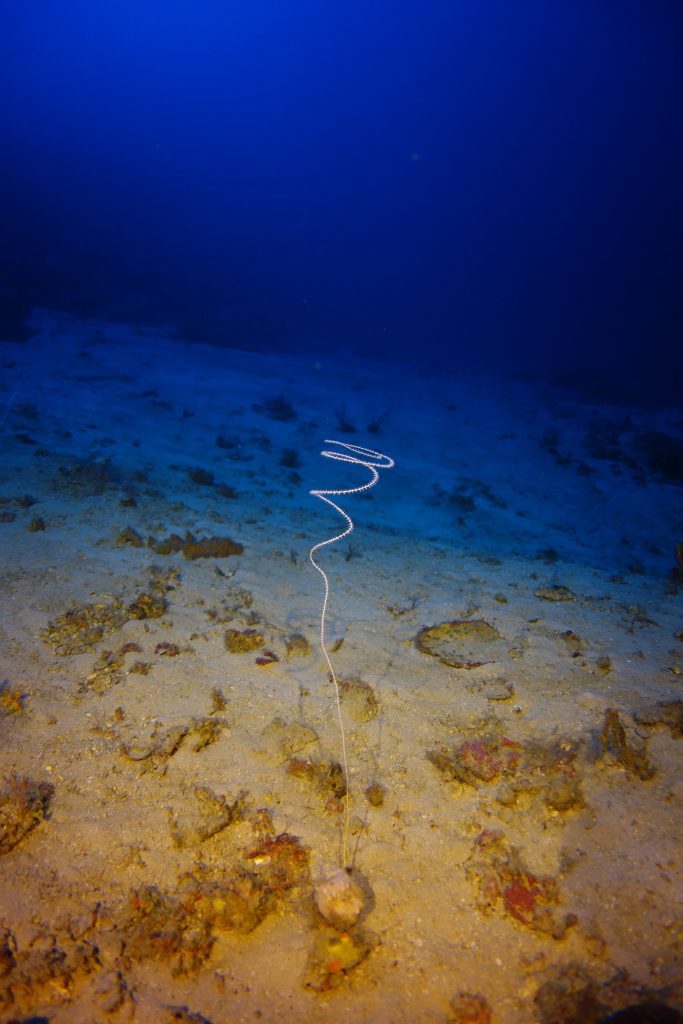
Depth: 79 m/259 ft
Max depth: 108 m/354 ft
Rebreather: Poseidon SE7EN
Dive time: 297 mins
Diluent: 10/73
G/F: 45/75
Buddy: T. E. Roberts, Tethys Images
Solitary survivors
This rarely encountered, delightfully delicate, and lyre-shaped coral is one that I see only at mesophotic depths. Typically perched upon the crest of old sea-level stands (ancient reefs), this form is likely capitalizing on a prominent position to catch food and attend to reproductive necessities.
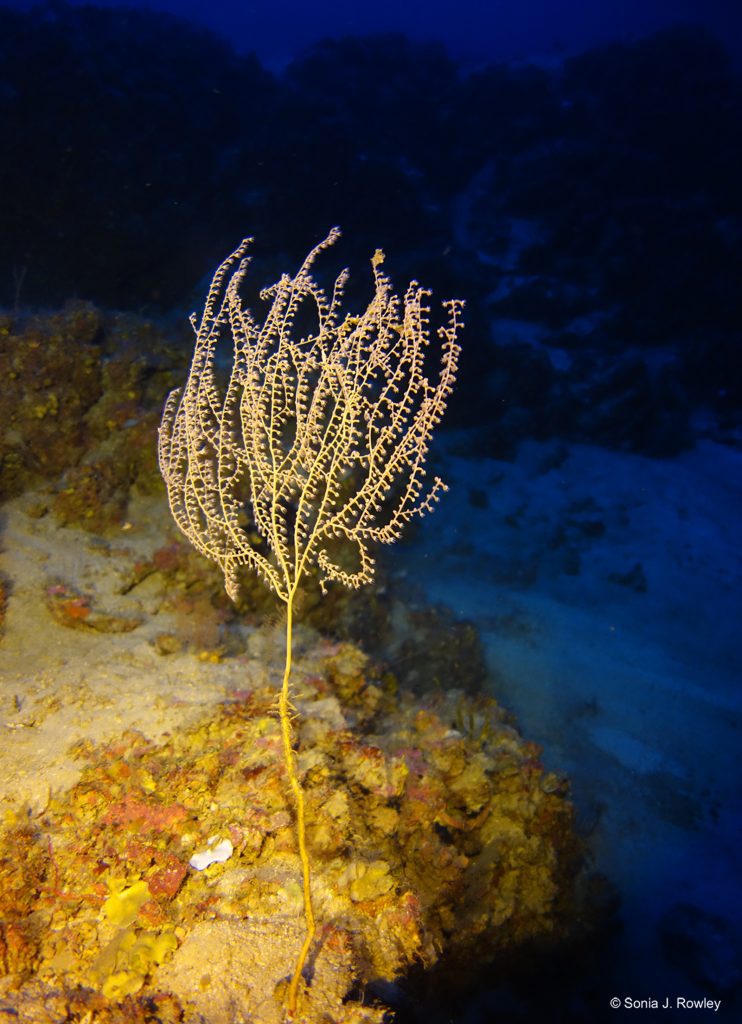
Depth: 83 m/272 ft
Max depth: 108 m/354 ft
Rebreather: Poseidon SE7EN
Dive time: 297 mins
Diluent: 10/73
G/F: 45/75
Buddy: T. E. Roberts, Tethys Images
Image link: www.instagram.com/p/CcrVpgIrnIw
Standing out in a crowd
Some species are all about maximizing space—hundreds of tiny mouths all packed in on the branches, themselves closely aligned. Nothing gets past this natural and highly effective filtration system. When you descend onto a beautiful mesophotic reef and encounter these giants, you know that the water flow is moderate to strong, and its contents rich in particulates. This mighty mouth ensemble is repeated many times in the evolutionary history of any coral group, but few are as ornate as those species within the Primnoidae Milne Edwards, 1857.
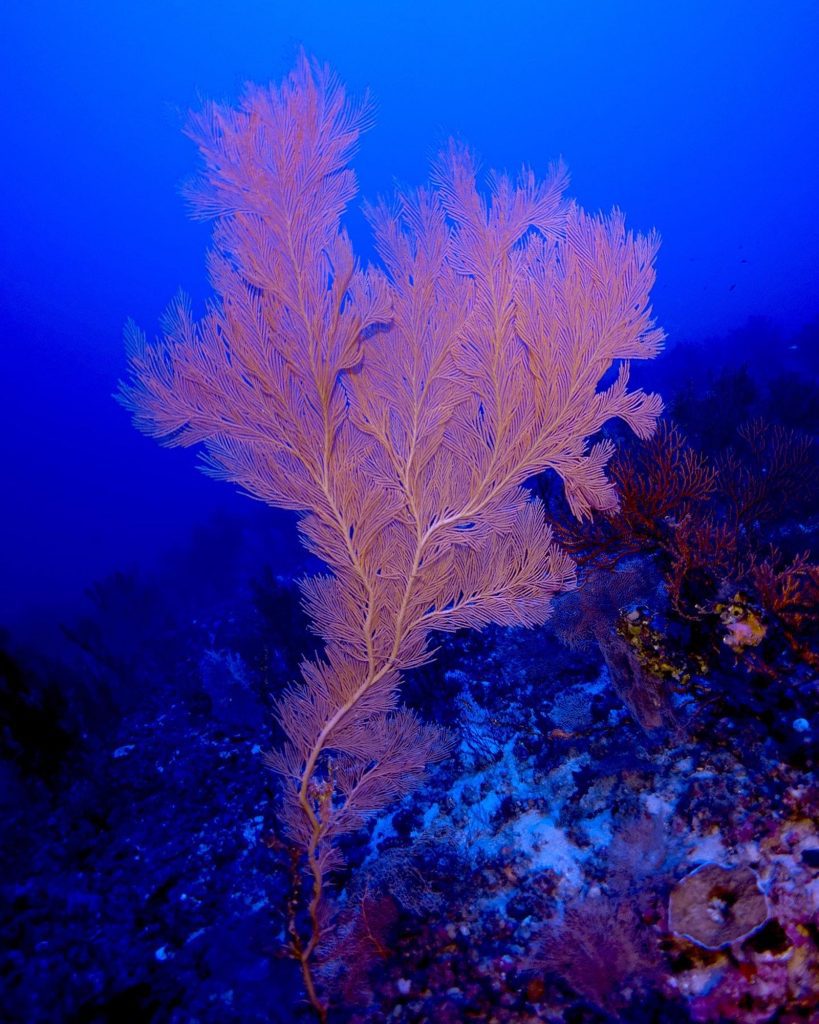
Depth: 80 m/262 ft
Max dive depth: 81 m/266 ft
Rebreather: Divesoft Liberty
Dive time: 174 mins
Diluent: 12/55
G/F: 45/80
Buddy: Sam Mason, Trawangan Diving
Image link: www.instagram.com/p/ChU22pcrxx5
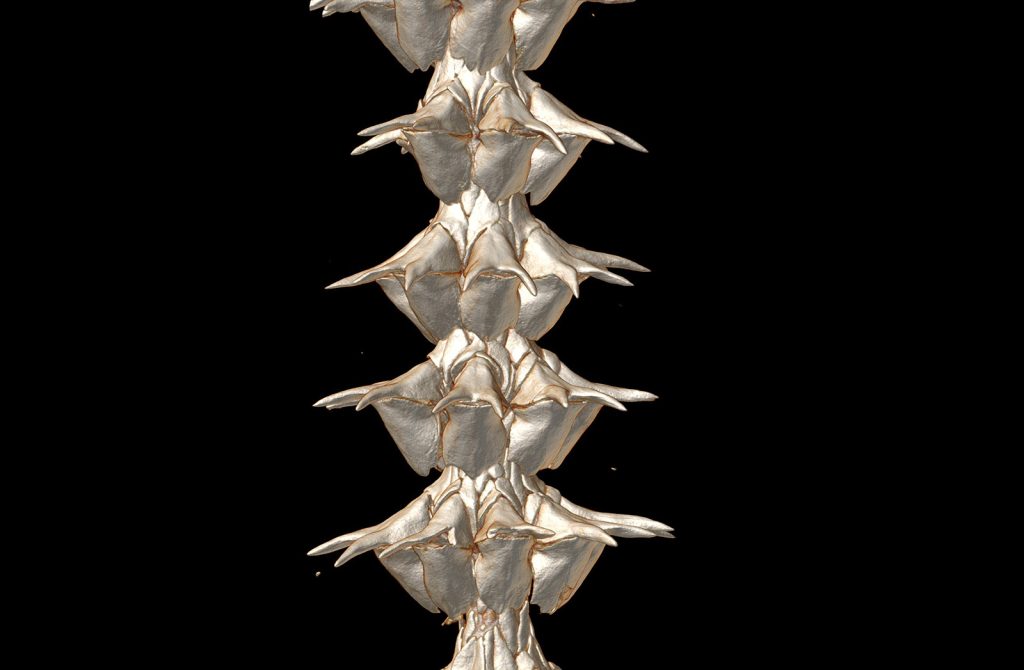
Depth: 1,027 meters/3,370 ft
Rebreather: Pisces submarine, HURL
Dive time: 8 hours
Diluent: Air
Scrubber: Lithium Hydroxide LiOH
Pilot: Max Cramer
Buddy: Michael Garland
Image link: www.instagram.com/p/CIZaFCFhZ10
The intrinsic beauty exhibited by the Primnoidae Milne Edwards, 1857 is arguably unparalleled throughout Octocorallia. Typically mesophotic and deep-sea specialists, the ornate structures manipulate the flow in which they live by creating turbulence and momentary retention of water in the polyp mouth (Rowley, unpublished data). A micro-CT scan (with Prof. Adam Summers) of the deep-sea Hawaiian Primnoid Calyptrophora wyvillie Wright, 1885 from the geologist seamount, McCall more than 50 miles southeast of the Big Island of Hawai’i. Sampled at 1,027 meters/3,370 ft depth.

Depth: 110 m/361 ft
Max dive depth:
Rebreather: Divesoft Liberty
Dive time: 364 mins
Diluent: 8/71
G/F: 30/80
Buddy: Carcharhinus amblyrhynchos (Bleeker, 1856)
Image link: www.instagram.com/p/B-I1U6EAOzk
Testing the hypothesis
The use of closed-circuit rebreather technology facilitates extended duration at deeper depths for experimental testing. Here, I am testing the mechanics of flow and feeding on the mesophotic gorgonian Annella Gray, 1858 at 110 m/361 ft. At these depths, internal waves cause huge variances in temperature, nutrients, and dissolved oxygen (to mention but a few variables). Yet, gorgonians couldn’t care less; with a 20°C variance in a single day, they just keep on feeding. Thus, they’ve been permitted to adapt naturally over the millennia, an opportunity not afforded to many of their shallow-water relatives.
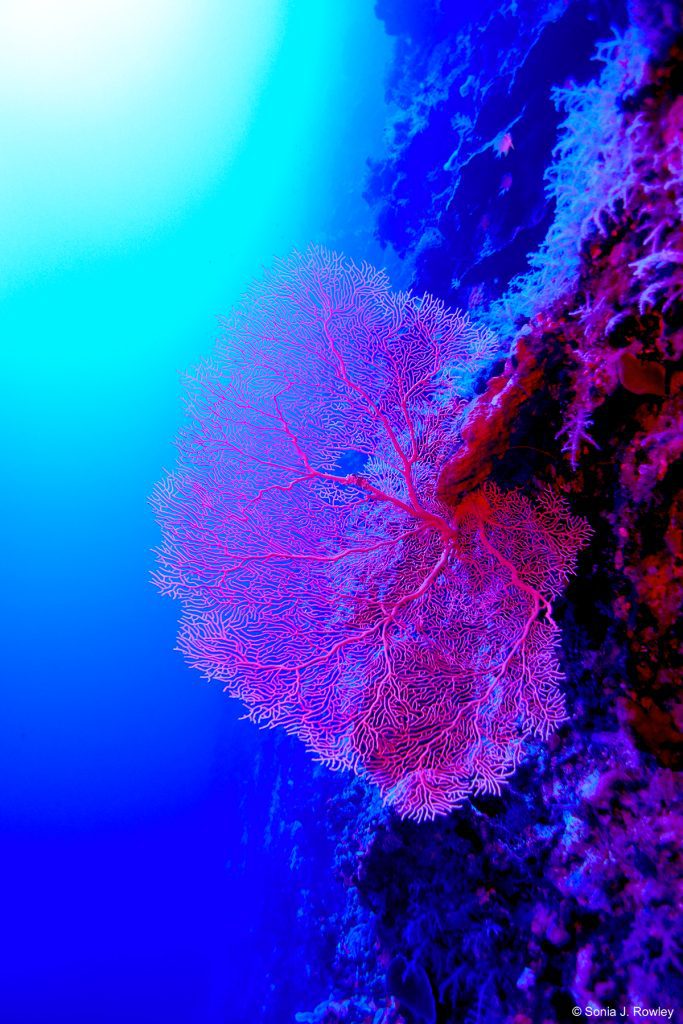
Depth of image/gorgonian: 60 m/197 ft
Maximum depth of dive: 95 m/312 ft
Rebreather: Divesoft Liberty
Dive time: 366 mins
Diluent: 10/65
G/F: 30/80
Buddy: Nature
Image link: www.instagram.com/p/CexQwq1g6EZ
Networking
To test a hypothesis, researchers may need to gather multiple lines of evidence on a variety of taxa. Such sleuthing typically generates more questions and subsequent tests that provide insight into the evolutionary processes at play. The gorgonian Annella Gray, 1858 and its network of branches (anastomoses) is an ideal candidate to develop our understanding of growth patterns and responses to hydrodynamic forces. Interestingly, in one specimen, compensatory growth 6 times that of the annual rate patched up a hole in the network in less than 12 months; nature maintains its structural integrity post disturbance.
Getting it on
Moderate to high flow and surge environments also spread the gorgonian seed. The rarely encountered Hawaiian mesophotic gorgonian, Melithaea bicolor (Nutting, 1908) can also be found nestled amidst many invertebrates of the shallow-water sandstone ceilings and pukas of O’ahu. A beautiful white colony is bursting with eggs, where it is actually possible to observe the eggs moving up and down within the tentacles themselves. Using my rebreather to study this Hawaiian endemic–thought to be found nowhere else in the world–in the shallow’s of O’ahu has allowed me to cut my macro skills in the surge for several hours at a time and develop a critical understanding of their functional morphology, particularly at depth. Thus, a rebreather is an excellent field tool irrespective of depth.
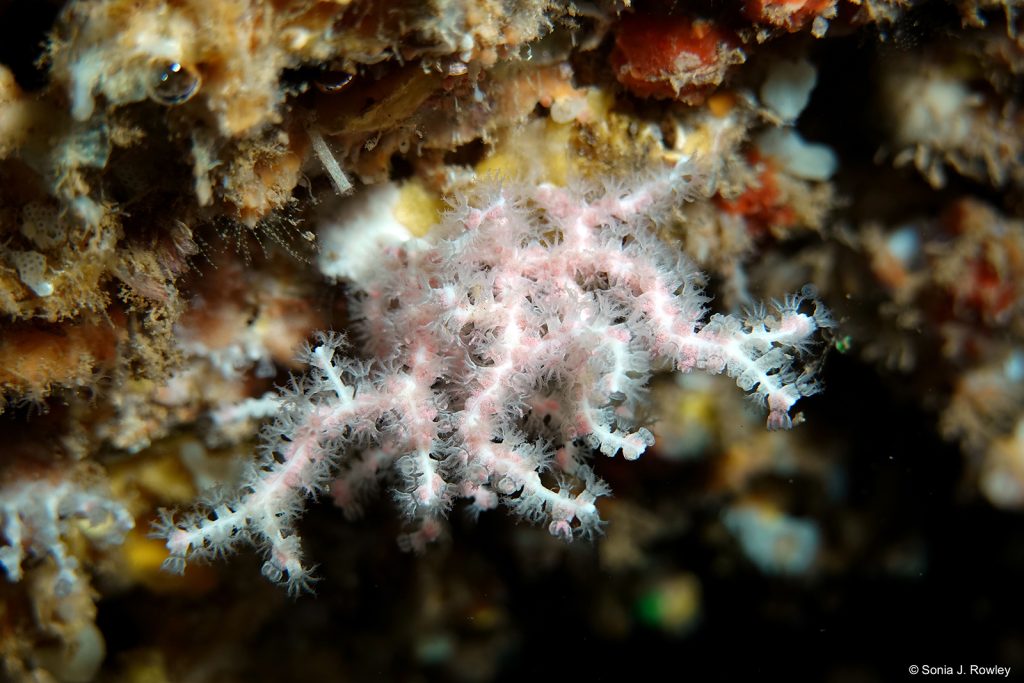
Depth: 12 m/39 ft
Max depth: 15 m/49 ft
Rebreather: Divesoft Liberty
Dive time: 262 mins
Mix: Air
G/F: 30/80
Buddy: Chrissy & Jason Richards
Image link: www.instagram.com/p/CRtDBduh5fk
When I descend into the ocean in search of these creatures, the true meaning of life comes into perspective, and everything else only facilitates the present moment. That’s it.

Dr. Sonia J. Rowley is a marine biologist; Divesoft Ambassador, Research Associate of the National Museum of Natural History; Fellow National of the Explorers Club (FN18), USA; Fellow of the Linnean Society of London (FLS); and Fellow of the Royal Society of Biology (MRSB), UK. She is the recipient of the Sir David Attenborough Award for fieldwork for her pioneering research on gorgonian octocorals at mesophotic depths. Dr. Rowley has over 38 years of diving and commercial ship experience throughout the world. She sees that the most powerful tool for change is sharing the knowledge and experience gained in the pursuit of scientific understanding and discovery—and to have as much fun as possible doing it while diving.
Disclaimer: All of Dr. Sonia J. Rowley’s diving activities and products thereof are not associated with the University of Hawai’i, nor does Dr. Rowley represent the University of Hawai’i in any way and with regard to any diving activities.”



















